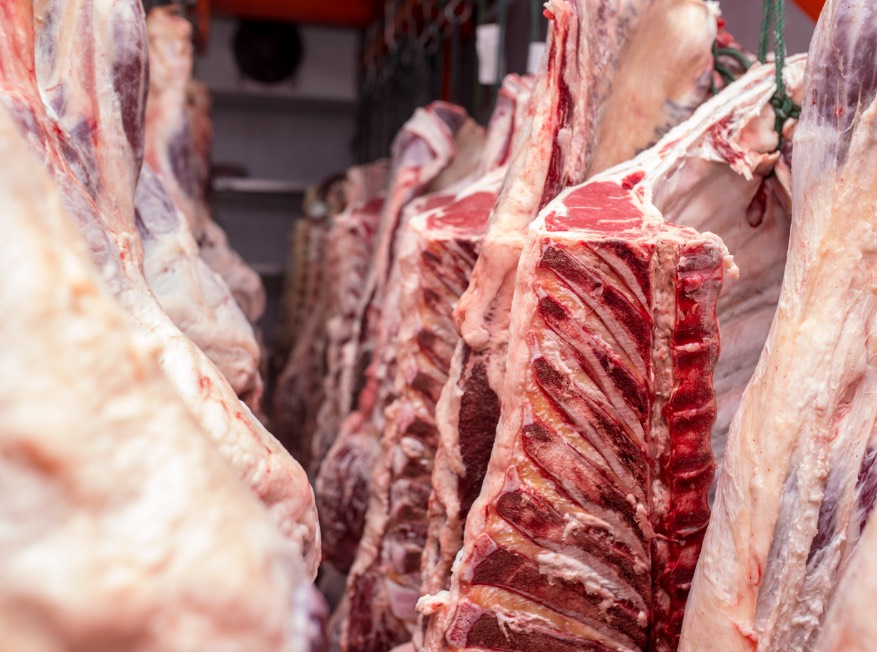
The colour of beef depends on the concentration of myoglobin – the main heme pigment. The level of myoglobin in the muscles of cattle depends on the breed and age of animals, as well as the degree of activity of the animals during grazing. The temperature of the environment where the animals are kept also has some influence on the colour of the meat – lower temperatures mean that the muscles are darker. For this reason, grazing cattle on pastures is one of the most important factors that shape meat quality. Cattle raised in the European Union spend part of the season grazing on the grass outside. Activity on pastures begins in early spring, as soon as the grasses turn green, and the browse reaches a height of about 10 cm, and continues until autumn. Traditionally, cows are fed with roughage (green fodder) from meadows with a rich composition of vegetation commonly found in the EU.
European beef is characterized by a fairly low fat cover, not exceeding 5%. The undoubted advantage of beef is also its high protein content, ranging from 18-23%. Beef contains many vitamins, mainly A, D, E, H, B12 as well as B1 and B6. It also contains more available iron than meat from other farm animals.
The intramuscular fat, which determines the degree of beef marbling, has a key influence on the final taste of meat, its juiciness and aroma. It has been proven that appropriate cattle breeding conditions can positively shape the fat profile of beef. Intramuscular fat consists of saturated fatty acids, monounsaturated fatty acids and polyunsaturated fatty acids. In terms of diet the content of CLA conjugated linoleic acid in beef, with proven pro-health effects (e.g. it prevents cancer, allows faster fat burning, improves the functioning of the immune system) is also important. Beef is especially rich in conjugated CLA linoleic acid – only lamb contains more of it.
In shaping the nutritional composition of beef, the selection of an appropriate nutritional strategy is key. A way to advantageously modify the fatty acid composition of meat is a slower growth rate of grazed cattle. This effect is achieved by the use of green fodder, pasture grazing or fodder with the addition of vegetable oils in the feeding of cattle. As a result, cattle has access to a rich feed consisting of many species of grasses, legumes and herbs.

MEAT MATURING
Beef tenderness is determined, among others, by sex and age of the cattle. In older animals, cross-linked forms of collagen are formed, which are insoluble at high temperatures. Being under 30 months of age for cattle is considered to be the boundary conditions for obtaining high-quality beef. It is such meat (from animals not older than 30 months) that is prepared for export to Japan and Hong Kong in accordance with the specifications of importers who order them.
Post-slaughter procedures are also important to obtain optimal meat tenderness. Fresh beef is firm and compact. During the post-slaughter maturation period, the processes of proteolysis, i.e. the breakdown of muscle proteins, take place in the meat, as a result of which the meat becomes softer and brittle. That is why proper seasoning is so important for the final quality of the product.
Maturing can be carried out using the dry and wet method. It is important to choose the right time and temperature.
Dry maturing
It means storing meat in large pieces, usually with bone, at a constant temperature (approx. 2-4 degrees Celsius) and appropriate air humidity, within 80%, for a period of several weeks. During this time, meat loses water, especially from the top layers, which are then cut off. The loss of moisture also means a lower final weight of meat, resulting in a higher price. The selection of the right conditions for maturation depends on many parameters, including the breed and age of the animal.
Wet maturing
It means the low-temperature storage of steak portion carcasses in vacuum packaging. The meat prepared in this way is kept in refrigerators for several weeks. It does not lose moisture in a vacuum package, but the processes of protein breakdown still take place in it, which makes meat tender and juicy.
Exporters from the European Union are able to provide Japanese and Hong Kong partners with high-quality beef with high sensory parameters and a method of preparation for further culinary processing, adapted to the expectations of importers. Contact details for companies authorized to export meat to Japan Hong Kong can be found here.




)
)